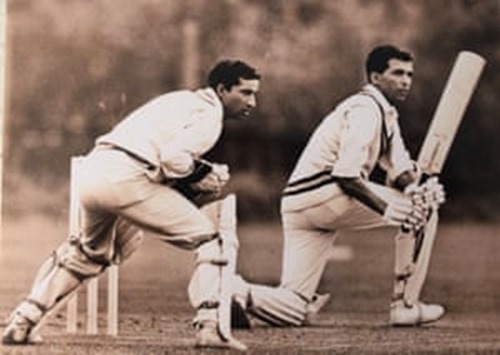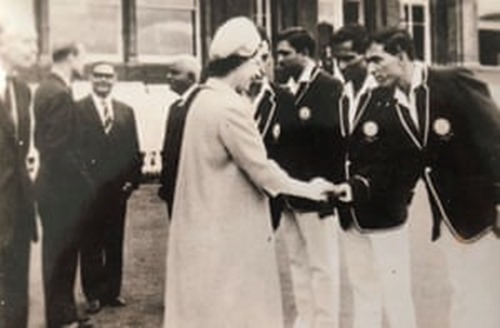Queenslanders saw one of their own in the first and only Indian Test player to play in the Sheffield Shield
Indian Test cricketer Rusi Surti plays a classic cover drive. ‘To see him perform in the middle was like sipping champagne and he gave endless pleasure to fans,’ says Kersi Meher-Homji. Photograph: Percy Surti
Fifty-three years ago, the second Indian Test team to tour Australia arrived, turning the wheel of history and sowing the seeds of the respect Virat Kohli’s modern-day team now enjoy. One player in particular on that tour, a man of ancient bloodlines, put in a display of all-round cricket that heralded the arrival of a new India.
“Rusi Surti would take no nonsense from anyone, which Australians could relate to,” says Kersi Meher-Homji, proud Parsi-Australian and author of 16 cricket books. “He was a brilliant cricketer – an elegant left hander who could bat like a millionaire, bowl like a miser and field like a superman. He was like a panther on the prowl.”
Surti was labelled “the poor man’s Garry Sobers”, a reference to his ability to do anything on the cricket field. He was left-handed like Sobers and a captain’s dream – a bowler capable of opening – swinging, seaming and even spinning the ball – and batting anywhere in the order. He was also a brilliant outfielder, slips fielder and brave close to the bat.
For Meher-Homji, watching Surti at work offered a new experience for Indian cricket fans. “To see him perform in the middle was like sipping champagne and he gave endless pleasure to fans.”
Surti playing in the Ranji Trophy for Gujarat. Photograph: Percy Surti
Rusi Framroze Surti was born in 1936 in Surat in the state of Gujarat and was a member of the Parsi community – a 1,200 year old Persian-Zoroastrian refugee colony which fled to India to avoid persecution. When the British East India Company took control of India, the Parsis found cricket was the only pathway to a level playing field and pioneered the way for later Hindu and Muslim teams.
They started the first local Indian cricket club in 1848, made the first tour of England in 1886 and there were two Parsis in the first Indian test team in 1932. These Parsi pioneers brought flamboyance, energy and confidence, and laid the platform for Indian cricket.
Surti moved to Bombay early in life and by the age of 11, his talents were being noticed. Indian captain Nari Contractor told the Times of India at the time: “Rusi was already a brilliant all-rounder who could do everything.” He was fast tracked into the Ranji Trophy and played for both Gujarat and Rajasthan, hitting a career high 246 not out for the former in 1959. That knock attracted the attention of Haslingden Cricket Club, who secured him as their club Professional in the Lancashire League.
His three-year stint in the north of England yielded 1,843 runs and 193 wickets and he became a popular figure at the club; Haslingden’s secretary Chris Aspin said Surti “was a very fine gentleman”. His sparkling form led to his India debut against Pakistan in 1960 in Mumbai, delighting the Parsi fans in attendance who witnessed the beginning of a nine-year, 26-Test match career. In his second Test, he was promoted to No 3 and scored 64, earning plaudits for his silky strokes, nimble footwork and solid temperament. Surti’s fielding too electrified the Indian fans, with his speed, great catching, laser-like returns and bravery when fielding close in, catching the eye.
It was on the five-Test tour of the West Indies in 1962 that Surti added courage under fire to his celebrated attributes. In a time before bouncer limitations, helmets, chest and arm guards, batting against the West Indies pace attack on home-cooked, spicy pitches was a life threatening experience. When some of the Indian top order batsmen experienced a failure of nerve, Surti volunteered to bat at three for the second Test. Captain Nari Contractor later said: “The real Rusi I saw was on this tour and he had the guts to face the West Indian pace attack. Rusi was a captain’s man and prepared to do anything for the team.”
Surti was at the non-strikers end when Contractor was felled by a vicious bouncer, ending his Test carer. Surti had warned both the umpire and Contractor that volatile Charlie Griffith was “chucking them”, but to no avail. Surti was providing a new template – he would verbally fight fire with fire if he felt his opponents crossed the line, a rarity for Indian cricketers at the time.
When the Indian team arrived in Australia for their four-Test tour in December 1967, they had played for 35 years and 43 Tests without winning one overseas. Although India lost all four matches, they came close to victory and impressed the Australian crowds. One player stood above his peers with a premium showcase of all round Test cricket.
Surti during India’s tour of England in 1967. Photograph: Original press photo
In the first Test in Adelaide, Surti stamped his authority on the game by scoring two half centuries and taking five wickets, the first Indian ever to achieve that feat in a Test. But it was his effort in the second Test in Melbourne that most captured the imagination. The Indian top order capitulated to 72-7 courtesy of a green pitch and a hostile Australian pace attack led by Graham McKenzie and Dave Renneberg. Surti had retired hurt earlier in the innings having been hit in the head from a bouncer and came out to resume his innings and help his captain, the Nawab of Pataudi, grind out a valuable partnership.
Teammate Bapu Nadkarni never forgot the innings and later told ESPN Cricinfo: “I have not seen a bigger fighter than him. He was proud of that innings, but would never talk about it himself.” By the time the Indians arrived in Brisbane for the third Test, the Queenslanders had seen enough and were preparing to table a historic offer. Surti put on another masterclass at the Gabba, fielding brilliantly, scoring two half centuries and taking six wickets.
An offer came in from Western Australia but Brisbane Lord Mayor Clem Jones intervened, matching the offer and ensuring Surti became a Queenslander – the first and only Indian Test player to play in the Sheffield Shield.
In early 1968, Surti spearheaded India to a historic double against New Zealand – their first overseas Test and series win. He scored a majestic 99 to set up the deciding fourth Test win and it capped Surti’s golden era – he scored more runs than any Indian across the Australia and New Zealand tours with 688 runs at 45.50 in addition to his 22 wickets. New Zealand writer Dick Brittenden wrote: “Surti looked the best of them as a batsman and comparisons made with Garry Sobers were in many respects valid. For watchfulness and sub-conscious elegance, he stood alone.”
For the following Indian home series in 1969, Surti was selected and relegated behind the spinners, yet he retained his fire. In his 26th and final Test at Brabourne Stadium in Mumbai, he twice rebuked Australian captain Bill Lawry, the first time for hitting a ball that slipped out of his hands and the second for Lawry’s swearing.
Surti was given the new ball for the Australian second innings with the tourists requiring 67 for victory. He charged in off a 12-step run up and defiantly broke Lawry’s stump in two, a unique feat in India in times of spin dominance. Surti kept the broken stump as a souvenir and later said: “The Australian victory was a foregone conclusion but I bowled with fire.”
The Spin: sign up and get our weekly cricket email.
The curdling of Surti’s Indian Test dream was the beginning of the end of the Parsi era and in 1975, Farokh Engineer retired, bringing the curtain down on the Parsi male Test cricket story.
The allure of a fresh start appealed to Surti and during his four years playing for Queensland he was a key contributor, including a magnificent century against Western Australia, in the face of Dennis Lillee and McKenzie. He also took the first ever hat-trick by a Queenslander and Australian Test bowler Geoff Dymock has fond memories of playing with Surti. “It was unusual to play with an Indian in those days but he was good value and a real nice fella who slotted easily into our team,” he said.
In Surti, Queensland saw one of their own – an aggressive direct style, a cocktail of skills to back it up and willingness to take the game on. In return, Surti found an unlikely group of kindred spirits in Queenslanders. When he retired, Surti decided to stay in Queensland, working as a cricket coach for another 35 years and his son Percy says his father found real meaning in the role. “Dad was happiest coaching hardcore Aussies in rural Queensland where they valued his experience and advice,” Percy says. “He found them very honest and really connected with them.”
Surti meets the Queen on his team’s 1967 tour of England. Photograph: Percy Surti
In 2013, while on a routine to trip to Mumbai, Surti had a stroke and Indian cricket’s original braveheart died, aged 76. He had presciently told his son Percy the year before that he wanted “to die in India” and got his wish. So what to make of Surti’s legacy and his role in Indian cricket history?
French composer Claude Debussy once said, “Music is the space between the notes”. This adage applies to Surti whose Test record of 1263 runs and 42 wickets should be rationalised beyond conventional cold metrics. Beyond stats he was the consummate team player who told Rediff in 2005: “I think today’s cricketers play too much for the records.”
When Indian confidence was fragile, Surti was a stoic bedrock of self assurance, aggressive with a strong moral code. Bravery begets bravery and he was the tip of the spear, an inspiration to his teammates and the right man at the right time for Indian cricket to make a crucial evolutionary leap and win away from home.
For former Australian captain Ian Chappell, Surti’s versatility was a captain’s dream. “The real value is that with Rusi in your team you could pick an extra bowler or batsman depending on the conditions,” Chappell says. Indian teammate Chandu Borde told ESPN Cricinfo that Surti’s best quality was his grit. “He was a jigar baaz (braveheart) cricketer,” he said. “He would never take things lying down, he always liked to fight it out.”
Sadly, his stint as a pioneer was largely unseen by Indian fans in the pre-televised era, but it had a big impact on Australians who were forced to reassess some hardened views on Indian cricketers as “one trick ponies”, who wilted away from their home conditions. This sentiment is confirmed by Chappell, who believes Surti’s presence and achievements had an indelible impact and should be widely celebrated. “Rusi came down here and matched us on our terms, not just a hero in his own conditions. He became one of us and we all looked at Indians differently after Rusi.”
It would be an injustice if Surti’s legacy is framed around the tyranny of comparisons and his sobriquet “the poor man’s Sobers”. Depending on the lens, his nickname is either an uncharitable assessment or the ultimate compliment.
Ian Chappell is adamant it’s the latter: “Like Sobers, Rusi was built for the modern game and they both did everything. He was a bit unlucky to cop that nickname because Sobers was the ultimate all round player. Being next in line still makes Rusi a damn good cricketer and lets face it, everybody was a poor mans Garry Sobers.”




